- Home
- Case studies
- Sapporo Kokyu Imono Co., Ltd.
Sapporo Kokyu Imono Co., Ltd.
Improved workplace environment and productivity by reducing odors within the factory

Sapporo Kokyu Imono Co., Ltd.
Improvement
Improvement
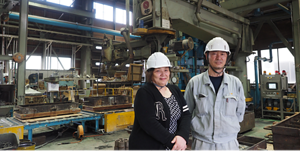
Sapporo Kokyu Imono Co., Ltd. (Sapporo, Hokkaido) is a foundry established in 1949. Initially Sapporo Kokyu Imono produced mainly farm equipment made primarily from cast iron in Hokkaido, a region of Japan characterized by its large number of farms, but now specializes in the production of cast steel and the production of special steel, with the variety of steel it produces exceeding 300.Pictured are Representative Director, Yuri Okuda (left) and Director/General Manager of Manufacturing, Hiroki Omura (right).
Introduction of required products and new methods
Since approximately 30 years ago when production shifted from cast iron to cast steel and other special steel, Sapporo Kokyu Imono added "furan self-hardening molding" to its original process of "green sand molding," relying on these two processes for production. In the time following, as orders for stainless steel increased, problems such as carburization and sulfurization occurred in these processes, and because they were not suited to grid molding, we introduced "VRH molding." However, due to the large amount of waste and casting defects, in 2015 we decided to introduce an environmentally friendly "alkaline phenol process" to resolve these issues.
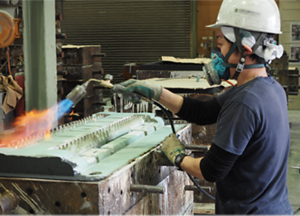
Picture of work
Our battle with odors unique to organic binders
Although we started producing molds using this alkaline phenol process, we were troubled by the pungent odor generated during this process.This same unique odor was also generated after pouring and spread around the factory. Director, Omura recalls how you could tell which employees had performed this work as soon as they returned to the office from the smell that remained on their clothes. Further, a large amount of steam is released when the mold is broken open, preventing employees from opening their eyes for a time afterward.
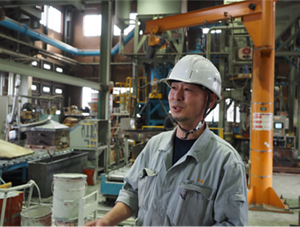
Mr. Omura reflecting on the hardships of the time.
Innovation meets experience
KAO STEP SH-8020, a new product, was developed after seeking advice from Kao-Quaker regarding these issues of smell and productivity. We were quick to introduce this new product at Sapporo Kokyu Imono. At the time, we experienced warping in some of the molding processes. However, harnessing the experience we have cultivated over many years, we resolved this problem by improving some of our work process and ultimately succeeded in producing high-quality castings. This was the moment that Kao-Quaker's technological innovation and our experience came together to achieve a drastic improvement in product quality.
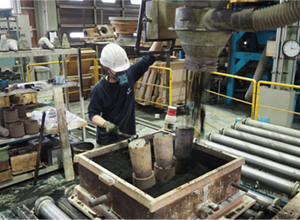
Wooden molds using artificial sand
KAO STEP SH-8020 is mixed in the sand.
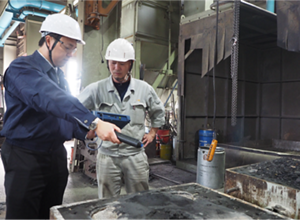
Mr. Omura staring at the odor check
It is said that the odor value is very different from before the introduction of KAO STEP SH-8020
Reduction of odors and irritation
Eye irritation, a problem experienced by workers when breaking open molds, was greatly reduced following the introduction of KAO STEP SH-8020. Odor measurements also showed that the reduction in odor levels exceeded the expectations of Kao-Quaker staff. Mr. Okuda has also experienced first-hand the drastic reduction in odor, recalling how before the introduction of KAO STEP SH-8020, passengers would leave the train when he boarded wearing his work clothes because of the smell that remained on them.
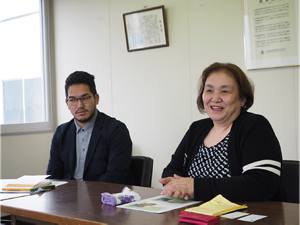
Ms.Okuda says she wants to make the change of the casting process an opportunity to think about building a sustainable society
From "What to make" to "How to make it"
We currently produce products that form a part of a variety of infrastructure, such as dust collectors used at incineration facilities and parts for pulp production equipment. At the same time, we face a sense of crisis in the casting industry, in that we have no notable products that are manufactured inhouse.“From now on, we have to think not about 'what to make' but about 'how to make it.' This will be our approach moving forward. I hope our experience coupled with the technical innovation of Kao-Quaker can help to brighten the future of the casting industry,” states President Okuda.
Product information
KAO STEP SH-8020 (alkaline phenol resin)
Improvement to the work environment
- Drastic reduction in the amount of formaldehyde generated during molding and pouring processes.
- Reduction in odor after pouring.
Improvement in mold strength
- Stronger molds are expected to help reduce the amount of resin used in the molding process.
Improvement in mold productivity
-
Hardening is fast, reducing the amount of time before the mold can be removed, improving mold productivity.
Technical information
Amount of formaldehyde generated
《Conditions》 Mold: 630 kg, Cast: 90 kg, Pour Temperature: 1,560 °C, Sand: Recycled Sand (artificial sand), Resin: 1.2% to Sand, Hardening Agent: 20% to Resin
-
Hardening is fast, reducing the amount of time before the mold can be removed, improving mold productivity.
Molding
1,000 g of kneaded sand was placed in a plastic bottle (1,000 ml) and sealed for 30 minutes. Amount of formaldehyde was measured using a formaldehyde detector tube.
Pouring
Formaldehyde was measured using a formaldehyde detector tube positioned 5 cm above the mold.

Odor emission after pouring
《Conditions》Mold: 30 kg, Cast: 6 kg, Pour Temperature: 1,400 °C, Sand: New Sand (silica sand), Resin: 1.5% to Sand, Hardening Agent: 20% to Resin
After pouring
Mold was covered with a stainless steel cover, and the gas generated after 55 minutes was collected and evaluated by a third party assessor.
Odor concentration
Dilution factor when no odor was apparent when odorous gas was diluted with odorless air

Major characteristics

- Home
- Case studies
- Sapporo Kokyu Imono Co., Ltd.

